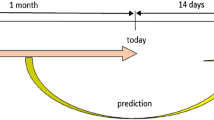Abstract
Covid-19 has exerted tremendous pressure on countries’ resources, especially the health sector. Thus, it was important for governments to predict the number of new covid-19 cases to face this sudden epidemic. Deep learning techniques have shown success in predicting new covid-19 cases. Researchers have used long-short term memory (LSTM) networks that consider the previous covid-19 numbers to predict new ones. In this work, we use LSTM networks to predict new covid-19 cases in Jordan and the United Arab Emirates (UAE) for six months. The populations of both countries are almost the same; however, they had different arrangements to deal with the epidemic. The UAE was a world leader in terms of the number of covid-19 tests per capita. Thus, we try to find if incorporating covid-19 tests in predicting the LSTM networks would improve the prediction accuracy. Building bi-variate LSTM models that consider the number of tests did not improve uni-variate LSTM models that only consider previous covid-19 cases. However, using a uni-variate LSTM model to predict the ratio of covid-19 cases to the number of covid-19 tests have shown superior results in the case of Jordan. This ratio can be used to forecast the number of new covid-19 cases by multiplying this ratio by the number of conducted tests.
Access this chapter
Tax calculation will be finalised at checkout
Purchases are for personal use only
Similar content being viewed by others
Notes
- 1.
111.
References
Arora, P., Kumar, H., Panigrahi, B.K.: Prediction and analysis of COVID-19 positive cases using deep learning models: a descriptive case study of India. Chaos, Solitons Fractals 139, 110017 (2020)
Bandyopadhyay, S.K., Dutta, S.: Machine learning approach for confirmation of COVID-19 cases: positive, negative, death and release. medRxiv (2020)
Brauer, F., Van den Driessche, P., Wu, J., Allen, L.J.: Mathematical Epidemiology, vol. 1945. Springer, Cham (2008). https://doi.org/10.1007/978-3-540-78911-6
Chandra, R., Jain, A., Chauhan, D.S.: Deep learning via LSTM models for COVID-19 infection forecasting in India. arXiv preprint arXiv:2101.11881 (2021)
Chen, J., Li, K., Zhang, Z., Li, K., Yu, P.S.: A survey on applications of artificial intelligence in fighting against COVID-19. arXiv preprint arXiv:2007.02202 (2020)
Cooper, I., Mondal, A., Antonopoulos, C.G.: A sir model assumption for the spread of COVID-19 in different communities. Chaos, Solitons Fractals 139, 110057 (2020)
Direkoglu, C., Sah, M.: Worldwide and regional forecasting of coronavirus (COVID-19) spread using a deep learning model. medRxiv (2020)
Elsheikh, A.H., et al.: Deep learning-based forecasting model for COVID-19 outbreak in Saudi Arabia. Process Saf. Environ. Prot. 149, 223–233 (2021)
Farooq, J., Bazaz, M.A.: A novel adaptive deep learning model of COVID-19 with focus on mortality reduction strategies. Chaos, Solitons Fractals 138, 110148 (2020)
Ghany, K.K.A., Zawbaa, H.M., Sabri, H.M.: COVID-19 prediction using LSTM algorithm: GCC case study. Inform. Med. Unlocked 23, 100566 (2021)
Goldstein, N.D., Burstyn, I.: On the importance of early testing even when imperfect in a pandemic such as COVID-19. Global Epidemiol. 2, 100031 (2020)
Hassoun, M.H., et al.: Fundamentals of Artificial Neural Networks. MIT press, Cambridge (1995)
Kermark, M., Mckendrick, A.: Contributions to the mathematical theory of epidemics. Part I. Proc. R. Soc. A 115(5), 700–721 (1927)
Lindemann, B., Müller, T., Vietz, H., Jazdi, N., Weyrich, M.: A survey on long short-term memory networks for time series prediction. Procedia CIRP 99, 650–655 (2021)
Lu, H., Stratton, C.W., Tang, Y.W.: Outbreak of Pneumonia of unknown etiology in Wuhan, China: the mystery and the miracle. J. Med. Virol. 92(4), 401–402 (2020)
Mills, C.E., Robins, J.M., Lipsitch, M.: Transmissibility of 1918 pandemic influenza. Nature 432(7019), 904–906 (2004)
Mohapatra, R.K., et al.: The recent challenges of highly contagious COVID-19, causing respiratory infections: symptoms, diagnosis, transmission, possible vaccines, animal models, and immunotherapy. Chem. Biol. Drug Des. 96(5), 1187–1208 (2020)
More, S., et al.: Pooling of nasopharyngeal swab samples to overcome a global shortage of real-time reverse transcription-PCR COVID-19 test kits. J. Clin. Microbiol. 59(4), e01295-20 (2021)
Muñoz-Fernández, G.A., Seoane, J.M., Seoane-Sepúlveda, J.B.: A sir-type model describing the successive waves of COVID-19. Chaos, Solitons Fractals 144, 110682 (2021)
Riley, S., et al.: Transmission dynamics of the etiological agent of SARS in Hong Kong: impact of public health interventions. Science 300(5627), 1961–1966 (2003)
Saidan, M.N., et al.: Estimation of the probable outbreak size of novel coronavirus (COVID-19) in social gathering events and industrial activities. Int. J. Infect. Dis. 98, 321–327 (2020)
Schmidhuber, J., Hochreiter, S., et al.: Long short-term memory. Neural Comput. 9(8), 1735–1780 (1997)
Tayarani-N, M.H.: Applications of artificial intelligence in battling against COVID-19: a literature review. Chaos, Solitons Fractals 142, 110338 (2020)
Vadyala, S.R., Betgeri, S.N., Sherer, E.A., Amritphale, A.: Prediction of the number of COVID-19 confirmed cases based on K-means-LSTM. arXiv preprint arXiv:2006.14752 (2020)
Wang, P., Zheng, X., Ai, G., Liu, D., Zhu, B.: Time series prediction for the epidemic trends of COVID-19 using the improved LSTM deep learning method: case studies in Russia, Peru and Iran. Chaos, Solitons Fractals 140, 110214 (2020)
Younis, M.C.: Evaluation of deep learning approaches for identification of different corona-virus species and time series prediction. Comput. Med. Imaging Graph. 90, 101921 (2021)
Zeroual, A., Harrou, F., Dairi, A., Sun, Y.: Deep learning methods for forecasting COVID-19 time-series data: a comparative study. Chaos, Solitons Fractals 140, 110121 (2020)
Author information
Authors and Affiliations
Corresponding author
Editor information
Editors and Affiliations
Rights and permissions
Copyright information
© 2022 The Author(s), under exclusive license to Springer Nature Switzerland AG
About this paper
Cite this paper
Al-Shihabi, S., Abu-Abdoun, D.I. (2022). What to Forecast When Forecasting New Covid-19 Cases? Jordan and the United Arab Emirates as Case Studies. In: Le Thi, H.A., Pham Dinh, T., Le, H.M. (eds) Modelling, Computation and Optimization in Information Systems and Management Sciences. MCO 2021. Lecture Notes in Networks and Systems, vol 363. Springer, Cham. https://doi.org/10.1007/978-3-030-92666-3_31
Download citation
DOI: https://doi.org/10.1007/978-3-030-92666-3_31
Published:
Publisher Name: Springer, Cham
Print ISBN: 978-3-030-92665-6
Online ISBN: 978-3-030-92666-3
eBook Packages: Intelligent Technologies and RoboticsIntelligent Technologies and Robotics (R0)




